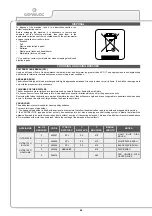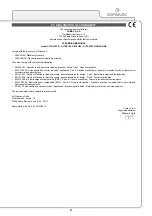
64
TROUBLESHOOTING
TROUBLESHOOTING
This chapter lists the most common problems linked with the use of the machine. If you are unable to resolve the problems with the information
given here, please contact your nearest assistance centre.
PROBLEM
POSSIBLE CAUSE
SOLUTION
THE MACHINE DOES
NOT START
The main switch is set to “0”.
Make sure that the main switch is at "I", if not turn the key a quarter
turn to right.
Check that when switched on there
are no alarm messages on the control
display.
Stop the machine immediately, and contact a specialised service
centre.
Check that the batteries are correctly
connected to each other (B versions).
Connect the jumper cables correctly.
Make sure the battery connector
is connected to the electric system
connector (B versions).
Connect the battery cable to the electrical system cable correctly.
Make sure the starter battery is
correctly connected (G versions).
Connect the supply cables correctly.
Make sure the alternator connector
is connected to the electric system
connector (G versions).
Connect the alternator cable to the electrical system cable correctly.
Check the battery charge level (B
version).
If the battery charge level is critical, perform a complete recharge
cycle (read
RECHARGING THE BATTERIES (B VERSIONS)
”).
Check the charge level of the starter
battery (G version).
If the battery charge level is critical, replace the battery (read
REPLACING THE STARTER BATTERY (G VERSIONS)
Low level of gasoline in the tank (G
versions).
Fill the gasoline tank (read “
Gasoline bypass tap closed (G
versions).
Open the gasoline bypass tap.
Low level of LPG in the cylinder (G
versions).
Replace the old cylinder with a new one (read “
Closed tap on the valve in the LPG
cylinder (G versions).
Open the valve tap.
THE BATTERIES
ARE NOT CHARGED
CORRECTLY (B
VERSIONS)
The connector of the battery charger
cable is not properly inserted in the
battery connector.
Connect the battery charger cable connector to the battery
connector again.
The power supply cable plug is not
correctly inserted in the mains socket.
Check that the battery charger power supply cable plug is
connected to the mains socket.
The characteristics of the mains
power supply do not correspond to
those required by the battery charger.
Check that the characteristics in the battery charger plate are the
same as those of the mains supply.
The LEDs of the battery charger blink
repeatedly.
Referring to the battery charger use and maintenance manual,
check the meaning of the flashing signals that the battery charger
emits dung the battery recharge stage.
THE MACHINE HAS
A VERY LOW WORK
AUTONOMY
Check the battery charge level by
checking the symbol on the command
display (B versions).
If the battery charge level is critical, perform a complete recharge
cycle (read
RECHARGING THE BATTERIES (B VERSIONS)
”).
Low level of gasoline in the tank (G
versions).
Fill the gasoline tank (read “
Low level of LPG in the cylinder (G
versions).
Replace the old cylinder with a new one (read “
THE MACHINE DOES
NOT MOVE
The machine does not start.
There is a fault on the drive pedal.
Check whether an alarm is being visualised on the display.
The parking brake is engaged.
Release the parking brake by means of the brake command lever
near the operator's seat.
Summary of Contents for ULTRA 120 B-G
Page 2: ......
Page 7: ...7 36 72 102 6 9 10 110 107 106 75 5 76 74 58 7 59 7...
Page 9: ...9 103 4 56 31 43 109 15 3 98 22 65 24 108 19 34 35 23 68 44 63 64 99...
Page 10: ...10 2 94 17 101 96 105 69 12 11 18 73 40 97 95 104 42...
Page 68: ...68 NOTES...
Page 69: ...69 NOTES...
Page 70: ...70 NOTES...
Page 71: ......

































